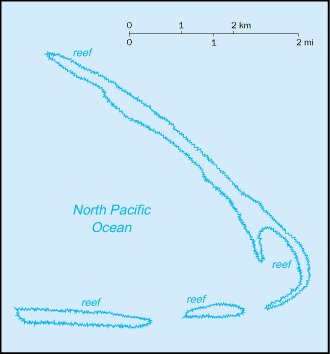
|
Kingman Reef
Background:
The US annexed the reef in 1922. Its sheltered lagoon served as a way station
for flying boats on Hawaii-to-American Samoa flights during the late 1930s.
There are no terrestrial plants on the reef, which is frequently awash, but it
does support abundant and diverse marine fauna and flora. In 2001, the waters
surrounding the reef out to 12 NM around the reef were designated a US National
Wildlife Refuge.
Location:
Location: Oceania, reef in the North Pacific Ocean, about half way between
Hawaii and American Samoa.
Area: Total: 1 sq km.
Area - comparative: About 1.7 times the size of The Mall in Washington, DC.
Coastline: 3 km.
Maritime claims: Exclusive economic zone: 200 NM, territorial sea: 12 NM.
Climate and Terrain:
Climate: Tropical, but moderated by prevailing winds.
Terrain: Low and nearly level.
Elevation extremes: Lowest point: Pacific Ocean 0 m, highest point: unnamed
location 1 m.
Natural resources: Terrestrial and aquatic wildlife.
Land use: Arable land: 0%.
Natural hazards: Wet or awash most of the time, maximum elevation of about 1
meter makes Kingman Reef a maritime hazard.
Geography - note: Barren coral atoll with deep interior lagoon; closed to the
public.
|
